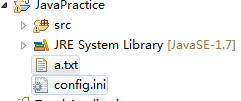java读写ini文件、FileOutputStream
今天在上课让学生练习文件读写,就让他们做了一个使用文件保存账号和密码的练习,有一个比较爱学的学生就用到了了.ini文件,也就是我们所说的配置文件来保存账号密码(学生很聪明,知道用键值对的方式保存密码,作为老师的我很汗颜啊!!!),我没仔细想就说你是不是进行了多次字符串分割来获取信息的,他说不是,只需要加几步代码就可以了。当时没细想说做出来就好……
后来我越想越不对,就回办公室自己写了一下,发现还是有很多问题的。
在查看文档的情况下,知道要读取类似于键值对的文件,java已经给我提供了一个叫 Properties的类,简单如下:
File file = new File("../JavaPractice/a.txt");
try {
FileInputStream inputStream = new FileInputStream(file);
Properties properties = new Properties();
properties.load(inputStream);//把文件中的内容放在流里面
properties.list(System.out);//通过这个方法把内容打印出来
inputStream.close();
} catch (FileNotFoundException e) {
e.printStackTrace();
} catch (IOException e) {
e.printStackTrace();
}打印如下:
-- listing properties --
a=b
12=222
asdasd1=asd111122
12123=123222如果要直接使用键得到值得代码如下:
File file = new File("../JavaPractice/a.txt");
try {
FileInputStream inputStream = new FileInputStream(file);
Properties properties = new Properties();
properties.load(inputStream);//把文件中的内容放在流里面
// properties.list(System.out);//通过这个方法把内容打印出来
System.out.println(properties.get("a"));//通过get方法得到对应值
System.out.println(properties.get("0"));//如果没有对应的值就为null
inputStream.close();
} catch (FileNotFoundException e) {
e.printStackTrace();
} catch (IOException e) {
e.printStackTrace();
}打印结果:
b
null使用properties.set()方法存值;
File file = new File("../JavaPractice/a.txt");
try {
FileInputStream inputStream = new FileInputStream(file);
Properties properties = new Properties();
properties.load(inputStream);//把文件中的内容放在流里面
// properties.list(System.out);//通过这个方法把内容打印出来
System.out.println(properties.get("a"));//通过get方法得到对应值
System.out.println(properties.get("0"));//如果没有对应的值就为null
properties.setProperty("java", "love java");//使用此方法存值
inputStream.close();
} catch (FileNotFoundException e) {
e.printStackTrace();
} catch (IOException e) {
e.printStackTrace();
} 我以为就这样就存进去,满怀欣喜的打开文件,发现并没有真正的存入值,但是我又试着使用properties.get()方法,却能得到我放进去的值,很是疑惑,只得再次看api。
File file = new File("../JavaPractice/a.txt");
try {
FileInputStream inputStream = new FileInputStream(file);
Properties properties = new Properties();
properties.load(inputStream);//把文件中的内容放在流里面
// properties.list(System.out);//通过这个方法把内容打印出来
System.out.println(properties.get("a"));//通过get方法得到对应值
System.out.println(properties.get("0"));//如果没有对应的值就为null
properties.setProperty("java", "love java");//使用此方法存值
FileOutputStream outputStream = new FileOutputStream(file);
properties.store(outputStream, null);//只有调用这个方法才能写进文件,因为前面set方法只是写在流里面,直到调用这个方法才真正的写入文件里。
inputStream.close();
outputStream.close();
} catch (FileNotFoundException e) {
e.printStackTrace();
} catch (IOException e) {
e.printStackTrace();
}new FileOutputStream 的位置有关系吗?
如果把FileOutputStream outputStream = new FileOutputStream(file);放在load前面,那么文件里面所有的信息都会被覆盖,放在load后面就不会了,因为load后就保存在一个流里面。
因为FileOutputStream outputStream = new FileOutputStream(file);就默认覆盖文件,直接是文件为空,除非FileOutputStream outputStream = new FileOutputStream(file,true);,所有有的时候初学者会把这些东西搞混淆,最后怎么出错也不知道。(汗颜!!!我也出过这个错误……)
最后细心的朋友可能会发现我并不是.ini文件,对的,我发现并不是只有ini文件才能做这样的操作,所以我就多试验了下。
共勉!























 377
377











 被折叠的 条评论
为什么被折叠?
被折叠的 条评论
为什么被折叠?










